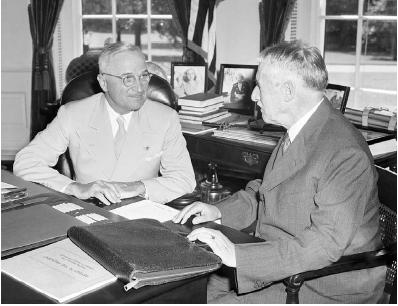Truman and Secretary of War Henry Stimson. “Stimson had to settle for persuading himself that the project was not intentionally targeting civilians, in the face of clear evidence to the contrary.”

From “The Men Who Dropped the Second Bomb,” Australian journalist Craig Collie’s modern account of the US atomic bomb attack on Nagasaki, 67 years ago today. The complete account appeared in London’s Telegraph, and can be read here.Collie is the author of Nagasaki, a 2011 reconstruction of the decision to drop “the forgotten bomb.” A fascinating 2011 interview with Collie by Australia’s ABC radio is here.
The crew of the B-29 Bockscar was not supposed to have targeted Nagasaki, a port city on Japan’s eastern coast. Cloud cover forced the mission’s commander to re-route the attack from its intended objective, the industrial hub Kokura. A third city, Niigata, was also on the target list that day, according to Collie.
“Henry Stimson, the US Secretary of War, was concerned that America’s reputation for fair play might be damaged by targeting urban areas. General George Marshall had a similar view, believing the bomb should be used first on military targets and only later on large manufacturing areas after first warning the surrounding population to leave. Both men’s views were ignored.
People in Hiroshima became aware that their city was not being subjected to the incendiary attacks of other cities. A rumour spread that President Truman’s mother had been imprisoned in Hiroshima Castle, that the American military had been instructed to spare the city.
Groves’s first choice was Kyoto. It was largely untouched by bombing and was psychologically important to the Japanese. Its surrounding mountains would focus the blast and thereby increase the bomb’s destructive force.
Stimson, who had visited Kyoto in the 1920s, knew its status as Japan’s intellectual and cultural capital and considered its destruction to be barbaric. He argued for Kyoto to be dropped from the list and eventually won Truman over to his view.
On July 25 1945 General Thomas Handy issued on their behalf an order to General Carl Spaatz, the Guam-based commander of US Army Strategic Air Forces, to ‘deliver’ the first ‘special bomb’ as soon after August 3 as weather permitted visual targeting. The target was to be selected from a list of four: Hiroshima, Kokura, Niigata and, added that day, Nagasaki.
The sub-committee had decided not to specify military-industrial areas as targets since they were scattered, and – apart from Kokura, which had a huge munitions factory in the middle of the city – generally on the suburban fringes. Aircrews were to select their own targets to maximise the effect on a city as a whole. The greatest impact would be achieved by aiming at the centre of a city, where the population was densest.
It wasn’t clear how the mass killing of civilians would drive the Japanese to capitulate. Japan’s cities had been firebombed since March, setting a precedent for targeting non-combatants, without any surrender resulting. Stimson had to settle for persuading himself that the project was not intentionally targeting civilians, in the face of clear evidence to the contrary.”


